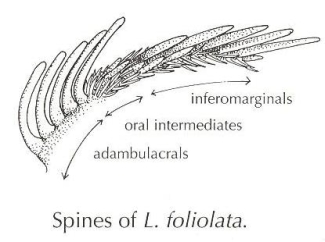Luidia foliolata is a long-armed, dull grey or brown sea star often partially buried in soft substrates. It has five arms up to 30 cm long, rectangular in cross-section. The arm-to-disc ratio is 3.4 to 7.1. The aboral surface is flat and the paxillae are of even height. The entire body is grey or has yellowish-white to light orange mottling; the tube feet are yellow to orange. The aboral surface consists of small, irregular paxillae down the centre of the arm, more square towards the edge; no spines or pedicellariae. Three vertical, flattened spines on the inferomarginal plates outline the arm when viewed from above; the remainder of the plate has smaller, flattened spines with fine spinelets around its perimeter. The row above the inferomarginals, normally the superomarginals, cannot be distinguished from the adjacent aboral paxillae. A single row of small, round oral intermediate plates bear a tuft of 5 spinelets, difficult to see unless all spines are removed. A transverse series of 3 to 5 slender spines are on the oral surface of the adambulacrals. The tube feet are large and pointed. The mouth plates are narrow but more elevated than adjacent adambulacrals. On the vertical edge nearest the mouth is a series of about 20 small spinelets; one or two series of larger suboral spinelets run the length of the plate. A group of 5 spinelets overhang the suture at the distal end of the mouth plate.
Characteristics
Similar SpeciesL. foliolata cannot be mistaken for any other species in this book.
